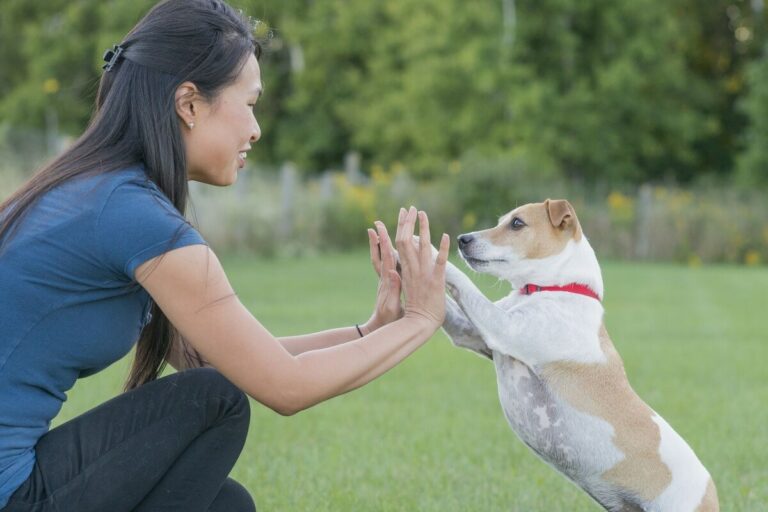Understanding Canine Communication: Decoding the Silent Language of Dogs
Understanding Canine Communication: Decoding the Silent Language of Dogs
The article discusses the importance of understanding dog communication signals, interpreting canine body language and signals, recognizing stress and conflict-related behaviors, identifying aggressive signals in dogs, communication between dogs and humans, and the benefits of understanding dog body language.

The Importance of Understanding Dog Communication Signals
Understanding a dog’s body language is crucial for building a strong relationship and minimizing frustration and misunderstanding. By being able to interpret their communication signals accurately, dog owners can respond appropriately to their pet’s needs and emotions. For example, recognizing stress signals in dogs, such as panting, lip licking, or yawning, can help owners identify when their pet is feeling anxious or uncomfortable. This understanding allows owners to create a supportive environment, reducing stress and building their dog’s confidence and communication skills [4].
Moreover, recognizing the different groups of canine communication signals, such as excitement, aggression, fear, and stress, is essential for dog owners. For instance, being able to distinguish between excitement and aggression can prevent misunderstandings and potential conflicts. When a dog is excited, they may exhibit behaviors like wagging their tail, jumping, or play-bowing. On the other hand, aggressive signals might include direct staring, raised hackles, or stiffened limbs. By accurately interpreting these signals, dog owners can appropriately address their pet’s needs and provide the necessary support.
In conclusion, understanding a dog’s body language and communication signals is not only crucial for promoting a healthy relationship with the pet but also for ensuring their emotional well-being. It allows owners to create a safe and supportive environment where dogs can communicate effectively, build confidence, and develop essential skills for interacting with humans and other animals.
Interpreting Canine Body Language and Signals
Understanding canine body language is crucial for dog owners to effectively communicate with their pets. Dogs use a variety of body signals to convey their feelings and intentions, including tail carriage, ear and eye position, body movement, and facial expressions. For example, a dog with a high, stiff tail and ears held forward may be expressing excitement, while a dog with a lowered head, ears, and tail may be conveying submission or fear. Observing these body language cues can help owners understand their dog’s emotional state and respond appropriately.
In addition to positive signals, it’s important for dog owners to recognize conflict-related behaviors that can arise in certain situations. When faced with contradictory motivations, dogs may exhibit behaviors that indicate stress or discomfort. For instance, a dog might yawn or engage in nose-licking as a way to cope with anxiety or tension. Recognizing these stress signals is essential for providing support and comfort to the dog in challenging situations.

Moreover, dogs display submissive signals as a way to reduce perceived threats and promote calmness. These signals can include avoiding direct eye contact, lowering ears and head, and tucking the tail. It’s important for owners to understand that these submissive postures are not indicative of guilt but are rather the dog’s way of attempting to avoid conflict and signal peaceful intentions. By interpreting and responding to these submissive signals appropriately, dog owners can create a supportive and safe environment for their pets, ultimately strengthening the bond between them and minimizing misunderstandings.
Recognizing Stress and Conflict-Related Behaviors

Understanding stress signals in dogs is crucial for dog owners to respond effectively to their pet’s needs. When dogs are stressed, their behavior can change significantly, and this can impact their response to various situations. For example, a stressed dog may exhibit behaviors such as lip licking, yawning, or panting excessively. In addition to these behaviors, dogs may also display appeasement signals, such as lowering their body, avoiding direct eye contact, or offering a paw. These signals are the dog’s way of attempting to reduce perceived threats and promote a sense of calmness in a potentially stressful situation.
Submissive posturing is another important aspect of dog communication that owners should be aware of. When dogs feel threatened or anxious, they may lower their ears, tuck their tail, and lower their body in a submissive posture. However, it’s important to note that these submissive postures are often misinterpreted as guilt by owners. In reality, these postures are the dog’s way of communicating and attempting to decrease the perceived threat in their environment.
Recognizing and understanding these signals can help owners provide the necessary support to their dogs and create a more secure and comfortable environment for them. By understanding both assertive and submissive body language, owners can actively work towards preventing threats and reducing potential conflict in their dog’s interactions.
Identifying Aggressive Signals in Dogs
Aggressive signals in dogs can be crucial for understanding their emotional state and preventing potential threats. One common aggressive signal is a direct stare, where a dog maintains eye contact with a person or another animal, signaling a sense of dominance or a warning. For example, when a dog feels threatened or cornered, it may resort to direct staring to assert control over the situation. This display of dominance is an important signal that should be recognized to avoid escalating the confrontation.
Another aggressive signal is snarling, characterized by the baring of teeth and a low growl. This behavior indicates that the dog feels threatened and is preparing to defend itself. For instance, when approached by a stranger or when feeling territorial, a dog may snarl to communicate its discomfort and deter potential intruders. Recognizing this signal is essential to avoid provoking the dog and to prevent any aggressive behaviors from escalating.

In addition, raised hackles and stiffened limbs are other aggressive signals that indicate a dog’s heightened arousal and readiness for confrontation. When a dog’s hackles are raised and its body becomes rigid, it is often a clear sign of agitation and a potential readiness to act aggressively. Owners and individuals interacting with the dog should be mindful of these signals, as they can be indicative of an imminent aggressive response.
Understanding these aggressive signals is crucial for dog owners and anyone interacting with dogs. By recognizing these signals, individuals can take appropriate measures to de-escalate the situation, prevent potential conflict, and ensure the safety and well-being of both the dog and the people involved.
Communication Between Dogs and Humans
Understanding how dogs communicate with humans is crucial for building a strong relationship and minimizing frustration and misunderstanding. Dogs primarily communicate non-verbally through body language and vocalizations, so it’s important for dog owners to be observant of their pets’ behavior. For example, a dog may use a combination of body language and vocalizations to express excitement, such as wagging its tail vigorously and emitting high-pitched barks. By recognizing these signals, owners can respond appropriately to their dogs’ needs and emotions, strengthening the bond between them.
In addition to visual and auditory cues, dogs also rely on tactile and olfactory communication. For instance, a dog may nuzzle or lean against its owner to seek comfort or affection, demonstrating the importance of physical touch in their communication. Moreover, dogs use their keen sense of smell to communicate with humans, often sniffing their owners’ hands, faces, or belongings to gather information about their environment. By understanding and responding to these different forms of communication, dog owners can create a supportive environment that fosters effective interaction and mutual understanding.
Furthermore, it’s essential to recognize that dogs may display behavioral asymmetries in their communication with humans. This means that certain signals or actions may carry different meanings when directed towards humans compared to when they are used in interactions with other dogs. For example, a dog’s playful growling during a game of tug-of-war may be misinterpreted as aggression by someone unfamiliar with canine behavior. Therefore, awareness of these asymmetries is vital for interpreting a dog’s communication accurately and responding appropriately to their needs and emotions.

Benefits of Understanding Dog Body Language
Understanding your dog’s body language is not only crucial for interpreting their needs and emotions but also for maintaining a harmonious relationship. By paying attention to your dog’s subtle cues, you can strengthen the bond and trust between you and your furry companion. For example, noticing that your dog is licking their lips or avoiding eye contact can indicate that they are feeling anxious or stressed, allowing you to provide them with the necessary support and reassurance.
Moreover, interpreting your dog’s body language can minimize frustration and misunderstanding. For instance, if your dog lowers their ears, tucks their tail, and averts their gaze, it could signify submission rather than guilt. Understanding this distinction can prevent misinterpretation of your dog’s behavior and help you respond appropriately, ultimately fostering a positive and stress-free environment for your pet.
Furthermore, recognizing and responding to your dog’s body language can contribute to their emotional well-being. By allowing your dog the freedom to make choices and respecting their signals, you can empower them to communicate their needs and build confidence in their interactions. This supportive environment not only enhances your dog’s emotional resilience but also promotes the development of their communication skills, enabling them to navigate social interactions with other dogs and humans more effectively. Therefore, understanding dog body language is not only beneficial for the individual well-being of your pet but also for the overall dynamics of your household and social encounters.
If you need help with your dog contact Dayton Off Leash K9 Training.
Would you like a certified trainer to contact you?








